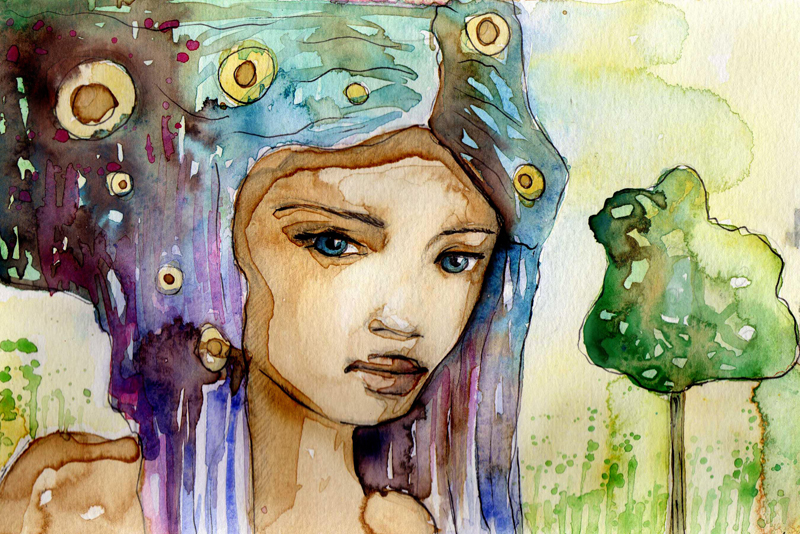Topstitching Concerns

Topstitching is that deliberately visible line of machine stitching seen on the outer edges of some finished garments produced by usually straight lines of stitching seen at the neckline, hems, collars, pocket edges occasionally at jacket lapel edges and cuff edges. Often a finishing option, topstitching secures finished fabric edges while at the same time allowing for a decorative outline of those edges.
Before beginning any topstitching, check the upper thread and presser foot tensions on a scrap of fabric, folded over same as the finished garment edge including any interfacing, to test if the line of stitching is straight and even. Adjust tensions as necessary.
Most woven fabrics and knits as well can be topstitched successfully, without distorting the carefully finished garment edges. Using a sewing machine needle compatible with the fabric and thread type are important. A final pressing of the finished garment edge is necessary to keep a crisp edge while topstitching.
Trim interior seam allowances close to the seamline before topstitching, to reduce any bulkiness at the seam edge once the seam is turned to the right side.
If possible use a topstitching guide on the presser foot or a line of painter’s tape on the machine bed to the right of the needle to visually aid in guiding the garment edge a consistent distance from the machine needle. This helps to produce an even stitching line. Stitch on the right side of the garment edge slow and steady keeping an eye on how evenly the stitches are spaced and using a longer stitch length than for general sewing.
For stitching success, a straight-stitch needle plate (different from a general needle plate on most machines that allows for the needle to produce the zig zag or decorative stitches) helps to keep any softer fabric from being pulled down into the needle hole opening. The machine needle then must be used in the centered position with this plate, however the fabric is evenly supported on both sides of the machine needle allowing for a more balanced stitch.
Although not mandatory, topstitching or embroidery needles, with their long eye that can accommodate denser or decorative threads are a help for great results as are spooled threads of a heavier weight than usually used for general sewing. Often two general weight sewing threads can be passed through the machine needle eye together for a more noticeable definition of the topstitching lines. Use regular thread for the bobbin.
There is no trick or secret hack to beautiful even topstitching, yet it does take practice and more than a cup of patience.
Sew happy, sew inspired.
Before beginning any topstitching, check the upper thread and presser foot tensions on a scrap of fabric, folded over same as the finished garment edge including any interfacing, to test if the line of stitching is straight and even. Adjust tensions as necessary.
Most woven fabrics and knits as well can be topstitched successfully, without distorting the carefully finished garment edges. Using a sewing machine needle compatible with the fabric and thread type are important. A final pressing of the finished garment edge is necessary to keep a crisp edge while topstitching.
Trim interior seam allowances close to the seamline before topstitching, to reduce any bulkiness at the seam edge once the seam is turned to the right side.
If possible use a topstitching guide on the presser foot or a line of painter’s tape on the machine bed to the right of the needle to visually aid in guiding the garment edge a consistent distance from the machine needle. This helps to produce an even stitching line. Stitch on the right side of the garment edge slow and steady keeping an eye on how evenly the stitches are spaced and using a longer stitch length than for general sewing.
For stitching success, a straight-stitch needle plate (different from a general needle plate on most machines that allows for the needle to produce the zig zag or decorative stitches) helps to keep any softer fabric from being pulled down into the needle hole opening. The machine needle then must be used in the centered position with this plate, however the fabric is evenly supported on both sides of the machine needle allowing for a more balanced stitch.
Although not mandatory, topstitching or embroidery needles, with their long eye that can accommodate denser or decorative threads are a help for great results as are spooled threads of a heavier weight than usually used for general sewing. Often two general weight sewing threads can be passed through the machine needle eye together for a more noticeable definition of the topstitching lines. Use regular thread for the bobbin.
There is no trick or secret hack to beautiful even topstitching, yet it does take practice and more than a cup of patience.
Sew happy, sew inspired.

Related Articles
Editor's Picks Articles
Top Ten Articles
Previous Features
Site Map
Content copyright © 2023 by Cheryl Ellex. All rights reserved.
This content was written by Cheryl Ellex. If you wish to use this content in any manner, you need written permission. Contact Cheryl Ellex for details.







